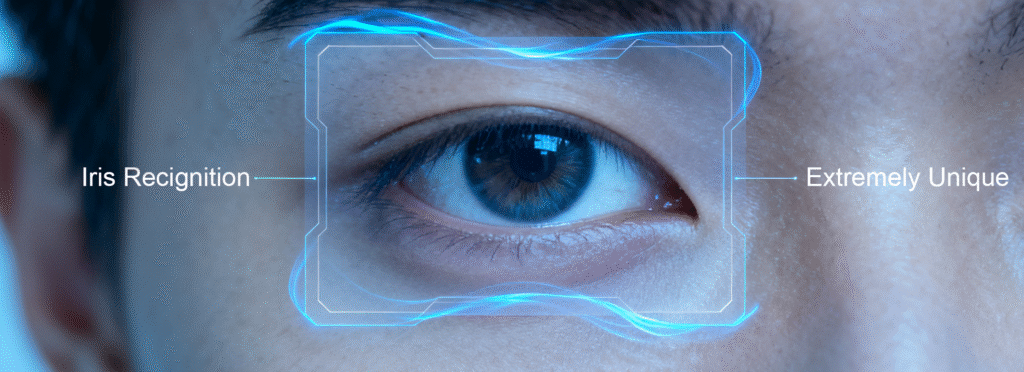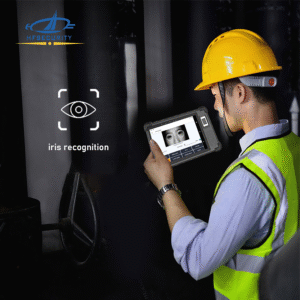What is an IRIS Scanner Biometric Device?
The IRIS scanner biometric device is a high-tech security solution that uses infrared light to capture a detailed image of a person’s iris. The iris— the colored part of the eye—contains unique patterns that can be used for identification. These patterns are highly distinct from person to person, even in identical twins, making the iris a reliable biometric trait.
By scanning the iris, the device creates a digital template that is then compared to a stored reference template. This process happens in seconds, providing a quick, secure, and non-invasive method of identity verification.
How Does an IRIS Scanner Work?
Ан IRIS scanner biometric device operates by shining infrared light onto the subject’s eye. This light highlights the unique patterns in the iris, which are then captured by a specialized camera. The device processes the captured image and converts it into a digital template. The template is stored in the system for future reference, enabling quick matching during authentication.
Iris scanning technology works in different lighting conditions and requires no physical contact, reducing the risk of contamination or discomfort. The process is entirely non-intrusive, making it ideal for environments where hygiene and comfort are essential, such as hospitals, airports, or office buildings.
Key Features of an IRIS Scanner Biometric Device
High Accuracy and Security
The iris is one of the most distinctive and stable biometric features, with complex patterns that are unique to each individual. Unlike fingerprints or facial features, iris patterns do not change with age or environmental factors, making iris scanning one of the most reliable and secure methods of biometric identification. This stability ensures that iris scanners provide an extremely high level of accuracy in identifying individuals.
Non-Intrusive Authentication
One of the major benefits of an iris scanner is its non-intrusive nature. Unlike fingerprint or palm print scanners that require physical contact, iris scanners rely on scanning the eye from a distance, ensuring a touch-free experience. This not only improves hygiene but also enhances user comfort, making the technology ideal for high-traffic areas like airports, schools, and offices.
Fast Processing Speed
Iris scanners offer rapid processing times, often completing the scanning process in less than one second. This allows for quick and efficient user authentication, which is especially important in environments where speed and convenience are key, such as airport security lines or employee access control systems. The device can simultaneously handle multiple users without delays, ensuring smooth workflow in busy settings.
Low Maintenance and Durability
Iris scanners require minimal maintenance, as they are typically less prone to wear and tear compared to contact-based biometric devices. The lack of moving parts or physical contact points reduces the likelihood of breakdowns, making them a durable solution for long-term use in challenging environments.
Adaptability to Diverse Environments
One of the standout features of iris scanners is their ability to function effectively in a variety of environmental conditions. Whether it’s under bright fluorescent lighting or in low-light situations, iris scanners use infrared technology to capture clear, accurate scans. This makes them suitable for a range of applications, including access control in secure facilities, immigration and border control, and attendance management in varying light conditions.
Enhanced Privacy Protection
With the iris being located behind the eyelid, it is less visible and vulnerable compared to facial features or fingerprints. This offers superior privacy protection during the biometric authentication process. Unlike facial recognition systems, which may capture sensitive facial data without consent, iris scanners only reveal the eye patterns when the user actively submits them for scanning, offering a more secure and discreet means of identification.
Benefits of Using an IRIS Scanner Biometric Device
Fraud Prevention: With its unmatched accuracy, iris scanning eliminates the risk of identity fraud. Unlike passwords or PIN codes, the unique patterns in an individual’s iris cannot be stolen or replicated.
Convenience and Speed: The process of scanning and matching takes just a fraction of a second, allowing for fast, frictionless user experiences in high-security areas or during attendance tracking.
Long-Term Stability: The patterns in the iris remain consistent throughout a person’s life, making iris scanning a long-term solution for secure identification without the need for re-enrollment.
Reduced Maintenance Costs: As a contactless and highly durable technology, IRIS scanner biometric devices require minimal maintenance. This makes them a cost-effective solution in the long run.
Applications of IRIS Scanner Biometric Devices

The versatility of IRIS scanner biometric devices has made them invaluable across various sectors:
Access Control Systems: Iris scanners are widely used for securing sensitive areas. In high-security locations like government buildings, data centers, and laboratories, only authorized personnel can gain access based on iris recognition.
Time and Attendance Management: In workplaces, IRIS scanner biometric devices are used for accurate employee attendance management. Iris scanning ensures that employees are not able to clock in or out for each other, eliminating fraud such as “buddy punching.”
Border Control and Immigration: Many countries are adopting iris recognition technology at border control stations. This system allows for faster immigration processing while ensuring that only authorized individuals are allowed to enter or leave a country.
Healthcare Sector: Hospitals and healthcare facilities use iris scanners to secure patient records, track staff attendance, and even identify patients. The non-contact nature of iris scanning is particularly beneficial in the healthcare sector, reducing the risk of contamination and infection.
Financial Services: In financial institutions, IRIS scanner biometric devices are employed for securing ATMs and providing access to sensitive banking services. Iris scanning offers a higher level of protection compared to traditional password or PIN systems.
Future of IRIS Scanner Biometric Devices
As the demand for higher levels of security continues to grow, the adoption of IRIS scanner biometric devices is expected to rise across various industries. The technology is evolving rapidly, with advancements in speed, accuracy, and integration with other security systems. Additionally, the growing trend towards contactless solutions, fueled by concerns about hygiene, is likely to drive further adoption of iris scanning in the future.
In the coming years, we can expect to see more seamless integrations of iris recognition technology in everyday life—from smart devices to public transportation systems. As the technology becomes more affordable and widespread, IRIS scanner biometric devices could soon become the standard for security and identity verification worldwide.
Заключение
In conclusion, the IRIS scanner biometric device represents one of the most secure, efficient, and non-intrusive biometric identification methods available today. Its unique ability to provide fast, accurate, and contactless authentication makes it ideal for a wide range of applications, from secure access control to attendance tracking. As biometric technology continues to advance, the iris scanner will undoubtedly play a pivotal role in enhancing security and streamlining identity verification processes across the globe.
Часто задаваемые вопросы
Ан IRIS scanner biometric device is a security system that uses advanced technology to scan and analyze the unique patterns in the human iris for identification. The device captures an image of the iris using infrared light and compares it to a stored digital template to authenticate the individual.
The IRIS scanner biometric device works by emitting infrared light onto the eye, which highlights the unique iris patterns. A specialized camera captures this image, and the device then converts it into a digital template that is matched with pre-registered data to verify the individual's identity.
Yes, IRIS scanners are contactless devices. Users do not need to touch the device. The iris scan is taken from a safe distance, which reduces the risk of contamination and enhances the user experience in environments requiring hygiene and comfort.
Some of the key benefits of an IRIS scanner biometric device include:
High accuracy and security
Non-intrusive and contactless authentication
Fast and efficient processing with minimal wait time
Enhanced fraud prevention by eliminating risks such as identity theft and "buddy punching"
Long-term reliability as iris patterns do not change with age
IRIS scanners are used in a variety of industries, including:
Контроль доступа in government buildings, data centers, and high-security areas
Time and attendance management in workplaces
Border control at immigration and customs checkpoints
Здравоохранение for patient identification and securing medical records
Financial institutions for securing ATMs and banking services
Ан IRIS scanner biometric device typically performs a scan in less than a second. The process is incredibly fast and does not disrupt user flow, making it ideal for high-traffic environments like airports, offices, and border control areas.
IRIS scanners are extremely secure and difficult to bypass due to the unique and highly stable patterns in the iris. Unlike passwords or PIN codes, iris scans cannot be easily guessed, stolen, or replicated, offering a higher level of security compared to other biometric methods like facial recognition or fingerprint scanning.



